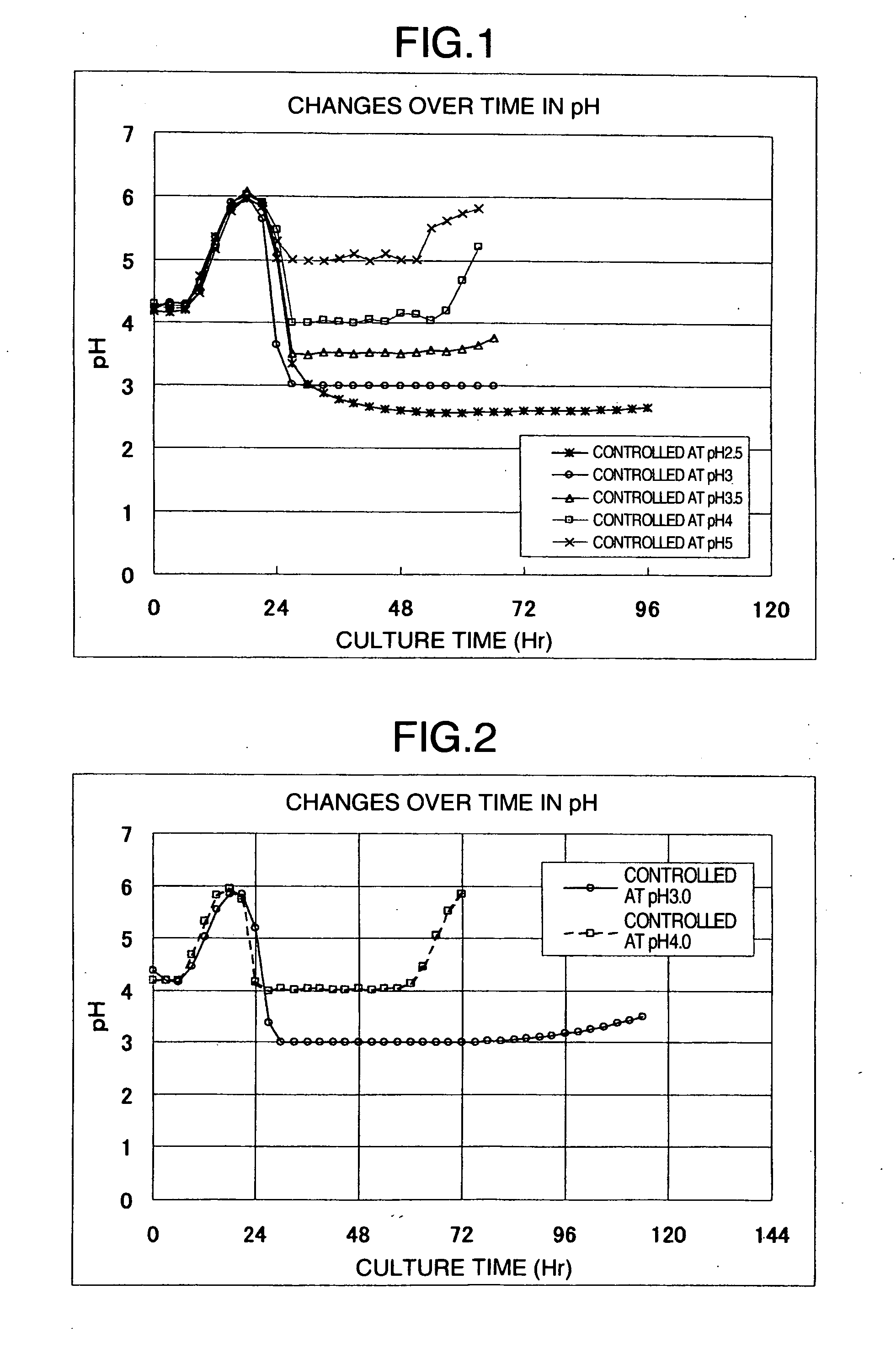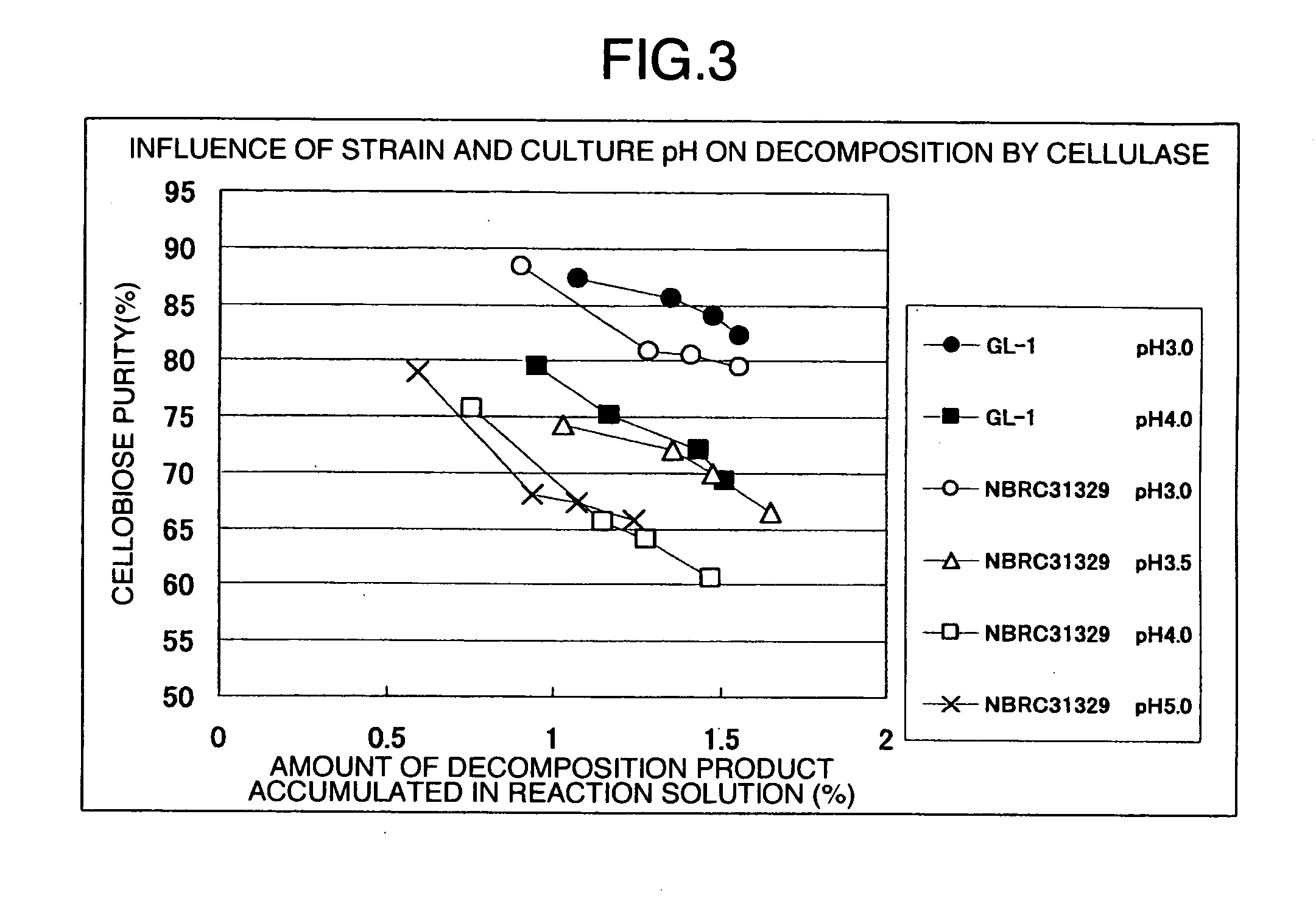Processes for Producing Cellooligosaccharide
- Summary
- Abstract
- Description
- Claims
- Application Information
AI Technical Summary
Benefits of technology
Problems solved by technology
Method used
Image
Examples
example 1
[0114] In a low-speed stirrer (30-L reactor), 2 kg of commercially-available dissolving pulp derived from a coniferous tree (average degree of polymerization: 781, diethyl ether-soluble substance content: 1.1%, average particle size: 174 μm) and 30 L of 3 N hydrochloric acid solution were placed and hydrolyzed with stirring at 105° C. for 30 minutes. The resulting acid-insoluble residue was filtered with a Nutsche and washed four times in 70 L of pure water to obtain wet cake having a solid content of 40.1% (average degree of polymerization: 220, diethyl ether-soluble substance content: 0.03% by mass, average particle size: 69.1 μm, colloidal cellulose content: 13.4% by mass, cellulose I crystals content: 85%).
[0115] A commercially-available cellulase preparation derived from Trichoderma (trade name: T“Amano”4) which had been dissolved in 0.2 N acetic acid-sodium acetate buffer (pH 4.5) was added to the wet cake so that the solid content and protein concentration of the wet cake we...
example 2
[0116] Commercially-available dissolving pulp derived from a coniferous tree (average degree of polymerization: 781, diethyl ether-soluble substance content: 1.1%, average particle size: 174 μm) was subjected to acid hydrolysis in the same way as Example 1. The resulting wet cake was made into a flock form, then placed in a flash drier at 60° C., and dried for 12 hours.
[0117] The resulting dried material was crushed with a home-use mixer, and the obtained crushed cellulose material was pulverized with an air-jet crusher (manufactured by Seishin Enterprise, trade name: Jet Mill STJ-2000 model) to obtain a cellulose powder (average degree of polymerization: 220, diethyl ether-soluble substance content: 0.03% by mass, average particle size: 16.4 μm, colloidal cellulose content: 17.5% by mass, cellulose I crystals content: 86%). This cellulose powder was used as a substrate and enzymatically decomposed in the same way as Example 1. The obtained result is shown in Table 1.
[0118] Exampl...
example 3
[0119] Commercially-available dissolving pulp derived from a broadleaf tree (average degree of polymerization: 1682, diethyl ether-soluble substance content: 0.9%, average particle size: 91 μm) was subjected to acid hydrolysis in the same way as Example 1. The resulting wet cake was supplemented with pure water to make a dispersion having a cellulose concentration of 10%. The dispersion was stirred for 30 minutes with a high-shear homogenizer (manufactured by Tokushu Kika Kogyo, trade name TK Homogenizer) to obtain a cellulose dispersion (average degree of polymerization: 151, diethyl ether-soluble substance content: 0.1% by mass, average particle size: 8.7 μm, colloidal cellulose content: 55.5% by mass, cellulose I crystals content: 85%). This cellulose dispersion was used as a substrate and enzymatically decomposed in the same way as Example 1. The obtained result is shown in Table 1.
[0120] Example 3 employed smaller average degree of polymerization, higher diethyl ether-soluble ...
PUM
| Property | Measurement | Unit |
|---|---|---|
| Temperature | aaaaa | aaaaa |
| Temperature | aaaaa | aaaaa |
| Fraction | aaaaa | aaaaa |
Abstract
Description
Claims
Application Information
 Login to View More
Login to View More - R&D
- Intellectual Property
- Life Sciences
- Materials
- Tech Scout
- Unparalleled Data Quality
- Higher Quality Content
- 60% Fewer Hallucinations
Browse by: Latest US Patents, China's latest patents, Technical Efficacy Thesaurus, Application Domain, Technology Topic, Popular Technical Reports.
© 2025 PatSnap. All rights reserved.Legal|Privacy policy|Modern Slavery Act Transparency Statement|Sitemap|About US| Contact US: help@patsnap.com


